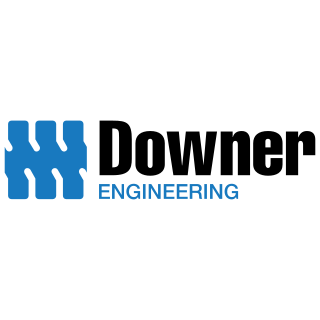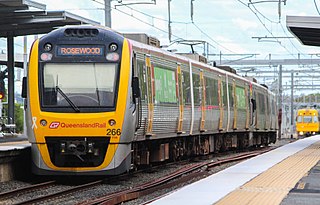
Downer Group is an integrated services company active in Australia and New Zealand.

Downer Rail is a business unit within the Downer Group. As well as manufacturing and maintaining railway rolling stock it holds maintenance contracts to maintain rail infrastructure. The head office is located in North Ryde.

UGL Rail is an Australian rail company specialising in building, maintaining and refurbishing diesel locomotives, diesel and electric multiple units and freight wagons. It is a subsidiary of UGL and is based in Melbourne, with a staff of 1,200 across Australia and Asia. It operates factories in Broadmeadow (Newcastle), Maintrain Auburn, Spotswood and Bassendean. While it used to operate a factory in Taree, the plant was shut down and the equipment sold off.

The Interurban multiple units (IMU) are a class of electric multiple units manufactured by Walkers Limited/Downer EDI Rail, Maryborough for Queensland Rail's Citytrain division between 1996 and 2011. The IMU is divided into in three subclasses, units 101-110 as the 100 series, units 121-124 as the 120 series, and units 161-188, as the 160 series.

Clyde Engineering was an Australian manufacturer of locomotives, rolling stock, and other industrial products.

The GT42CU AC is a model of diesel electric locomotives manufactured by EDi Rail, Maryborough between 1999 and 2005 under licence from Electro-Motive Diesel, for use on narrow gauge railways in Queensland.

The Emu Bay Railway was a Tasmania, Australian railway company. The railway was significant during full operation, in that it linked the Tasmanian Government Railways system at Burnie with that at Zeehan that further linked to the Mount Lyell railway allowing connection through to Queenstown.

The Suburban multiple units (SMU) are a class of electric multiple units manufactured by Walkers Limited/Downer EDI Rail, Maryborough for Queensland Rail's Citytrain division between 1994 and 2011. The SMU is divided into in three subclasses, units 201-212 as the 200 series, units 221-250 as the 220 series, and units 261-296, as the 260 series.

Evans Deakin & Company was an Australian engineering company and shipbuilder. In 2019, the company was inducted into the Queensland Business Leaders Hall of Fame in recognition of its major contributions to the Queensland economy for nearly a century through excellence in heavy engineering, construction and ship building.

Hervey Bay railway line, sometimes known as Urangan railway line, is a closed railway line in Queensland, Australia. It was opened in 1896 to Pialba and it was extended to Urangan in 1913. It was extended to the end of the Urangan Pier in 1917, along with the opening of the pier. It was closed in 1993.

The GT42CU ACe is a model of diesel electric locomotives manufactured by EDi Rail, Maryborough between 2007 and 2013 under licence from Electro-Motive Diesel, for use on narrow gauge railways in Queensland, South Australia and Western Australia.
The BHP Whyalla DH class were a class of diesel locomotives built by Walkers Limited, Maryborough for the BHP's Whyalla Steelworks between 1962 and 1968.

Wide Bay–Burnett is a region of the Australian state of Queensland, located between 170–400 km (110–250 mi) north of the state capital, Brisbane. The area's population growth has exceeded the state average over the past 20 years, and it is forecast to grow to more than 430,000 by 2031. It is the subject of the Draft Wide Bay–Burnett Regional Plan, which aims to facilitate this growth while protecting over 90% of the region from urban development.

The DH class is a class of diesel-hydraulic locomotives built by Walkers Limited, Maryborough for Queensland Railways between 1966 and 1974.

The M/MA class are a class of diesel-hydraulic locomotives built by Walkers Limited, Maryborough for the Western Australian Government Railways in 1972–1973.

Maryborough railway station is a heritage-listed railway station at Lennox Street, Maryborough, Fraser Coast Region, Queensland, Australia. It is on the North Coast line serving the city of Maryborough. It was designed by Chief Engineer of the Queensland Railways Department and built from 1878 to 1890 by John Roddam & John Walker. It was added to the Queensland Heritage Register on 21 October 1992.

The Cooloola Tramway is a heritage-listed tramway at Great Sandy National Park, Cooloola Recreation Area, Cooloola, Gympie Region, Queensland, Australia. In the 1870s it was known as the Kaloola Railway. It is also known as Cooloola Railway, SEQ-5N 22, Pettigrew's Railway, and Pettigrew's Tramway. It was added to the Queensland Heritage Register on 12 July 2013.

The Emu Bay Railway 11 class were a class of diesel-hydraulic locomotives built by Walkers Limited, Maryborough for the Emu Bay Railway between 1969 and 1971.

The Diesel Tilt Train is the name for three high-speed tilting trains, operated by Queensland Rail on the North Coast line from Brisbane to Cairns as part of its Spirit of Queensland service.

The Electric Tilt Train is the name for two identical high-speed tilting trains operated by Queensland Rail for the Tilt Train service on the North Coast line from Brisbane to Rockhampton which entered service in November 1998.


























